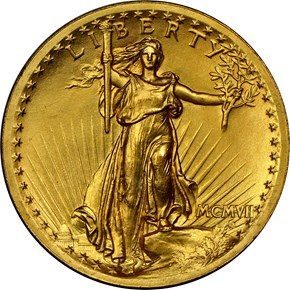Blog
1907 High Relief Double Eagle
It doesnt take a professional numismatist to label the 1907 High Relief Double Eagle as one of the most beautiful coins out there. In the photo you’ll see a side-by-side displaying a 1908 St. Gaudens in MS65+ (left) and a 1907 St. Gaudens High Relief AU58 (right). You can see the 3D effect in the AU58 High Relief. Hands-down one of the most impressive gold coins ever produced by the United States!!
Below are two of the better articles written about the 1907 High Relief Double Eagle.

The 1907 High Relief Double Eagle is one of the most popular coins ever struck by the United States Mint. The coins are sculptural in appearance and are considered by many to be the most beautiful regular issue gold coin ever produced.
Unfortunately, the design was also impractical and redesigned by Charles Barber later in the year. The date is given in Roman numerals (the coins nickname by some) and lacks the Motto, IN GOD WE TRUST. President Roosevelt believed that money could easily be used for ungodly pursuits such as gambling and thus the name of the Lord should not be used on coinage.
The 1907 High Relief is categorized by most as either Wire Rim or Flat Rim. The coins are identical except for raised metal around the rims. This is probably the result of some tinkering by the Mint while they struggled to produce coins with such extreme relief.
Around the late 1960s or early 1970s experts began to describe certain 1907 High Relief Double Eagles as  Proof. These coins are certainly different, but not exactly like the latter Proof Double Eagles of the series. There are no mintage figures and the origins of the coins are a mystery. The coins have deep swirling die lines and exhibit a satiny surface similar to the Roman finish Proof gold coins. A fairly large number exist and it is my opinion that they are the result of experimentation with the new design by Mint employees.
Proof. These coins are certainly different, but not exactly like the latter Proof Double Eagles of the series. There are no mintage figures and the origins of the coins are a mystery. The coins have deep swirling die lines and exhibit a satiny surface similar to the Roman finish Proof gold coins. A fairly large number exist and it is my opinion that they are the result of experimentation with the new design by Mint employees.
Many, if not the great majority of the original mintage was saved when the 1907 High Reliefs were issued. Thousands still exist and most seen are in some form of Mint State. Gem examples can easily be purchased if budget permits. A few nearly flawless examples are known. The finest High Relief graded by NGC is a PR 69 that sold for $534,000 in 2005.
written by Jeff Garrett for NGCcoin.com
The 1907 High Relief Double Eagle is, in my opinion, the most beautiful coin the United States ever issued for normal circulation. Unfortunately, it was not as practical as it was beautiful; the high relief of the standing figure of Liberty and the eagle made the coin impossible to stack properly and thus unpopular and unsuitable for commercial purposes. Minting was also impractical since it reportedly required five blows of the minting press to fully bring up the design making high speed, mass production impossible.
Of the 11,250 High Reliefs minted, it is my estimate that 2/3 to 3/4 of this total were the Wire Rim variety since the Flat Rim is at least two to three times as rare as the Wire Rim. The difference between the two varieties was unintentional, i.e. the Mint did not purposely set out to make one variety and then alter the design to make a second variety. (In this regard, the Wire Rim and Flat Rim Double Eagles are not analogous to the Wire Edge and Rolled Edge Eagles which were totally different coins.) The Wire Rim and Flat Rim Double Eagle varieties resulted from the use of different collars. in the case of the Wire Rim variety, the collar was not sufficiently tight and the pressure of the repeated blows forced metal up where the edge of the coin meets the collar to form a very thin wire rim. On most Wire Rims, this raised metal encircles the whole coin, both obverse and reverse, while on the Flat Rim variety, the edge is flat, if not beveled.
The 1907 High relief is much more common than its low mintage (the lowest of the entre Saint-Gaudens series) would imply. Obviously, many specimens were saved due to both the coins’ novelty and their beauty. Most existing High Reliefs (both Wire Rim and Flat Rim varieties) are uncirculated and many of them are gem and even superb quality. The circulated examples are almost always high grade and many, if not most, received their wear from being used as jewelry or pocket pieces rather than from commercial use. The plentiful auction records for the Wire Rim would seem to indicate that it is one of the half dozen most common issues in the entire series. In my view, it is not that common, but I do think that one interesting claim can be made for it, namely the 1907 Wire Rim High Relief is the highest priced U.S. coin for its rarity. (The 1895 Proof Morgan Dollar and 1879 Flowing Hair Stella are two other candidates for this distinction, but I think the High Relief is the easy winner with respect to ratio of its high price to low rarity.)
All High Reliefs were struck a minimum of three to five times , so it is not surprising that they are always fully struck. Most specimens are very frosty but many of them have a very satiny texture and often display a myriad of raised die swirls and scratches in the fields. Lustre is always excellent and the color is most often a light to medium greenish gold. A few specimens have a coppery hue, however.
written by David Akers for PCGScoinfacts.com

